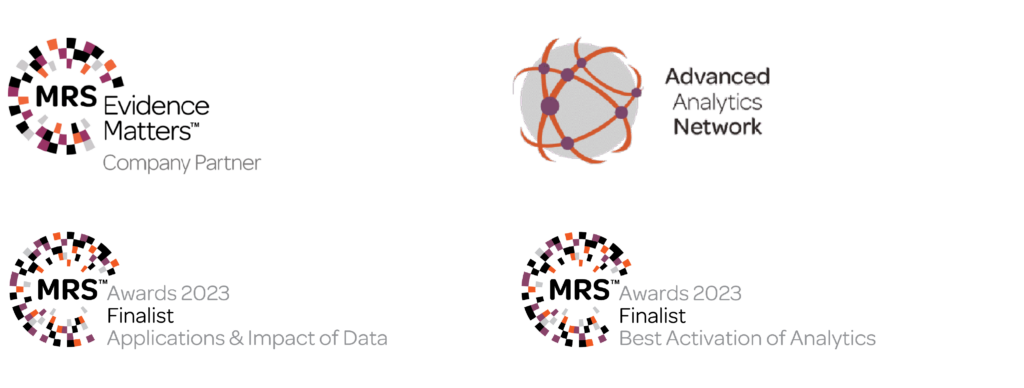The rapid evolution of generative AI in recent years has sparked a wave of excitement and apprehension in equal measures. One thing is undeniable though: it’s fundamentally changing how we gather, analyse, and utilise insights.
As with any major disruption, separating fact from fiction is crucial. This blog series aims to do just that.
We debunk some of the most common myths surrounding AI in market research and present a clear picture of how AI can be harnessed to unlock new and powerful insights that were previously out of reach.
But before we delve into our first myth, you may be wondering…
What gives us the right to be talking to you about AI?
Well, AI is in our blood. Our journey with AI began in 2005, when we started using machine learning predictive algorithms and building our own cluster analysis toolkits. Well before the recent surge in generative AI, we were developing language models and leveraging AI to answer business questions from unstructured data (such as text and imagery). And in the past year alone, we’ve pushed the boundaries further with our own Semiotics AI solution and strat7GPT, a secure version of ChatGPT. So, we’ve learnt a lot!
What gives us the right to be talking to you about AI?
In early 2023, there was a great deal of scepticism surrounding generative AI. Many thought it just hype, readily dismissing its potential, or simply couldn’t see its relevance to their role, team, or company. In other words, it was no more than a distraction. Typical concerns from researchers and clients alike were…
“I’m not sure what I’ll get from an AI delivery?”
“I’d like to do something, but I’ll need to convince procurement.”
“There are a lot of companies talking about it, but not actually doing anything.”
Fast forward a year and, fortunately, a much more positive reality has emerged. In fact, some of our clients are almost in disbelief at the impact AI is having on what they do – in a good way. As a result, we’re witnessing a rapid shift in adoption, with clients moving rapidly from trying out to embracing AI.

The value of AI is clear
Recent breakthroughs in AI and online data collection have opened the door for businesses to gather consumer insights from social media, blogs, forums, and review sites at an unprecedented scale and speed.
We see the adoption of AI in four flavours:
- Before primary research (providing stimulus and direction)
- After primary research (validation and deployment)
- Accelerating primary research (by replacing steps in programme with quicker methods)
- Filling in for primary research (through its agility and scale)
- Collected online reviews for a global software company and its competitor set to help analyse consumer needs and pain points before qual research – in four different markets.
- Set up and run an online brand tracker for a global luxury fashion company, filling in the gaps between a biannual quant survey. Purely using unstructured data and AI.
- Used our Semio AI capability with STRAT7 Crowd DNA to analyse images for cues about the drivers of loyalty across categories.
- Analysed 1,000s of public documents to uncover the link between customer centricity and financial performance.
- Benchmarked the performance for a UK restaurant chain, based on online reviews and conversations.
- Diagnosed heartburn pain points for US consumers for a global healthcare provider.
- Shaped talent strategy for a global pharma company using employee feedback sites.
- Improved TV commercials from years of community panel open-end feedback.
“An Insight department using generative AI is always going to outperform Insight departments that aren’t.”
New ways to deliver
We’re also seeing AI transform the nature of research, opening up entirely new methods for delivery, for instance:
- Using Large Language Models (LLMs) to extract information from dozens of transcripts, creating as much information as a quant study but all from open ended responses, rather than prompted questions.
- Using webscraping of public sources and PDF documents to analyse competitor intelligence on a huge scale.
- With the help of strat7GPT (our own secure chatbot), building a Segmentation Chatbot with a variety of proprietary datasets.
The power of proof of concepts
One way we help clients navigate their AI journey is by building proof-of-concepts. These allow them to compare the advantages and limitations of AI versus traditional approaches before fully committing.
Here’s a real-world example. A client wanted to replace a desk research model with an exhaustive AI – led data collection and modelling project focused on competitors in multiple markets. This project combined AI technology with ‘humans in the loop’ to control the data collection sourcing and the topic area outputs, which varied by market.
By collecting 10,000s of online verbatims and combining this with relevant PDF report extracts, our client has been able to pinpoint competitor movements with more precision and confidence before expanding to more markets and turning into a repeatable workstream.
Take a look at the next blog in our series which covers two opposing views – AI Myth #2: Humans are better but AI will still replace me!


